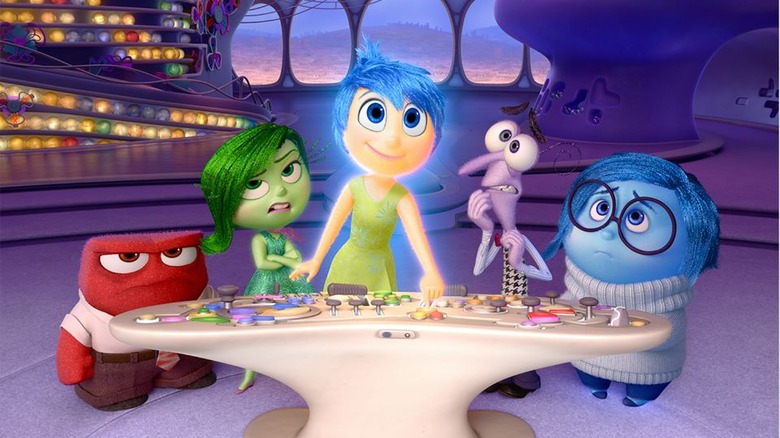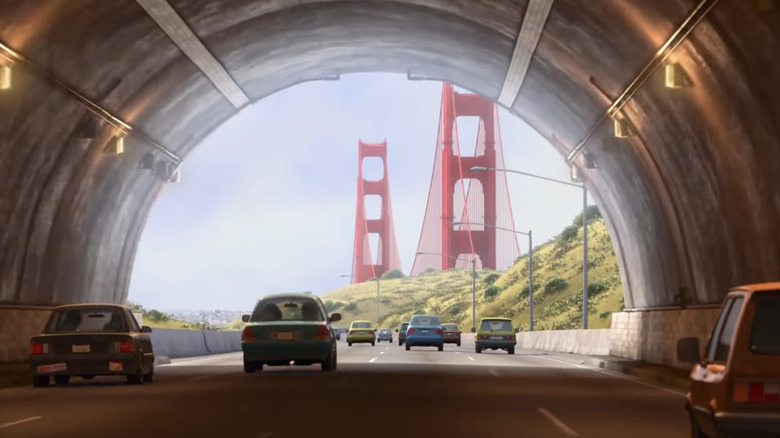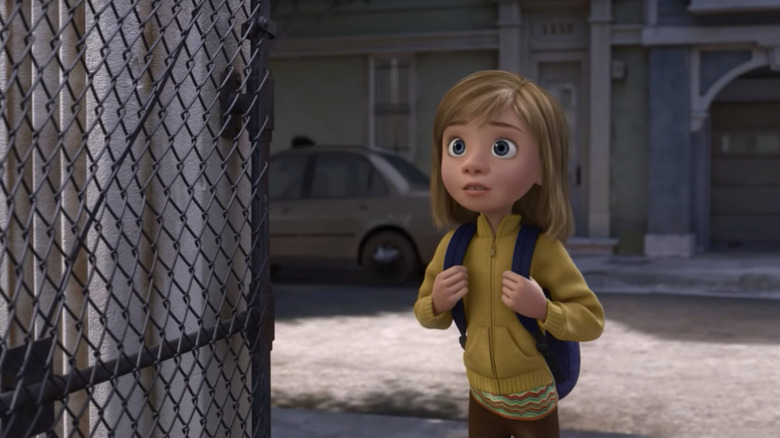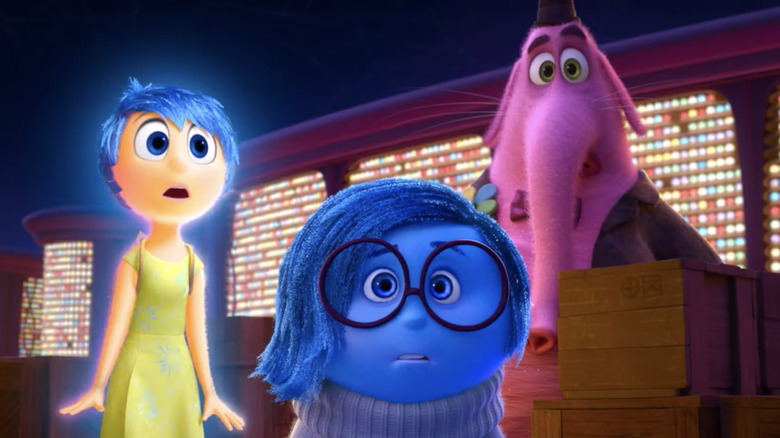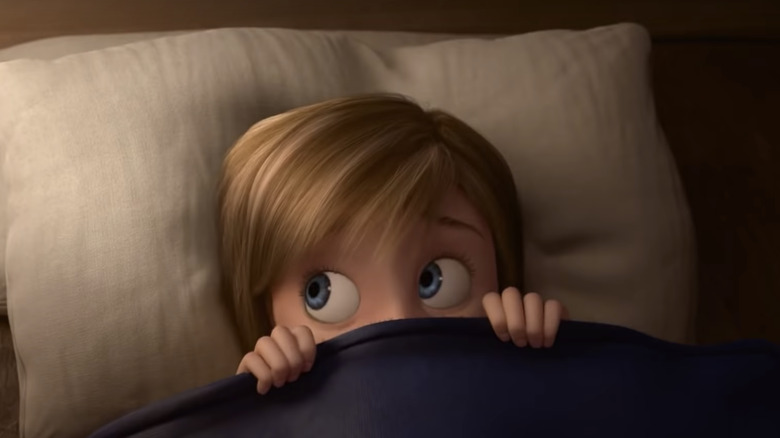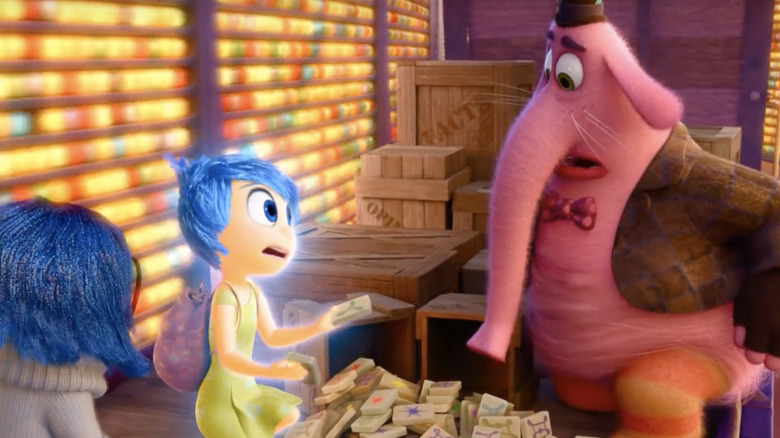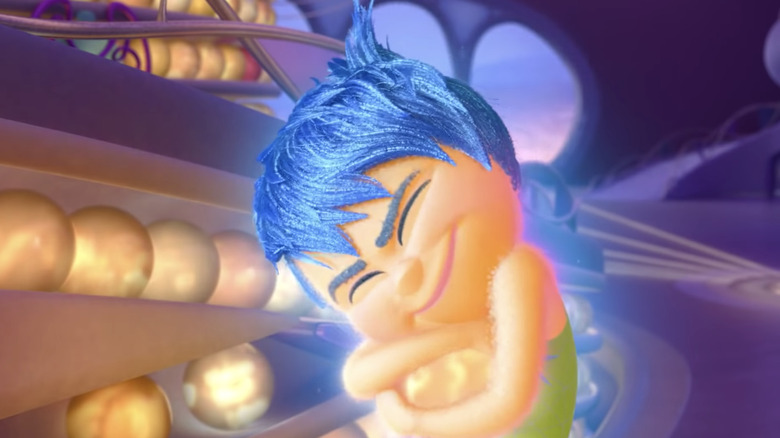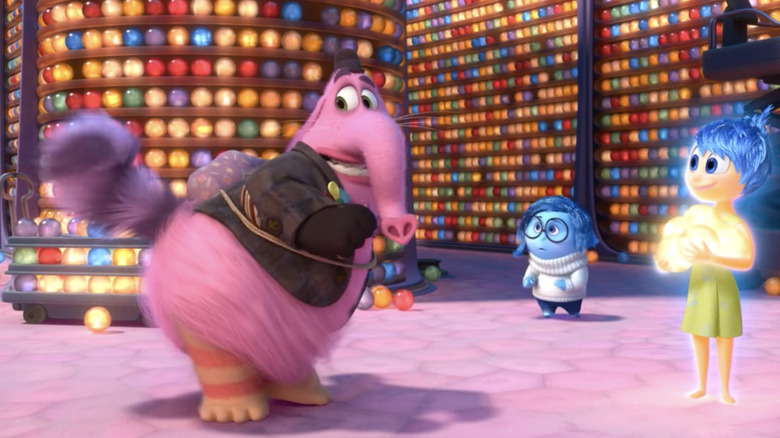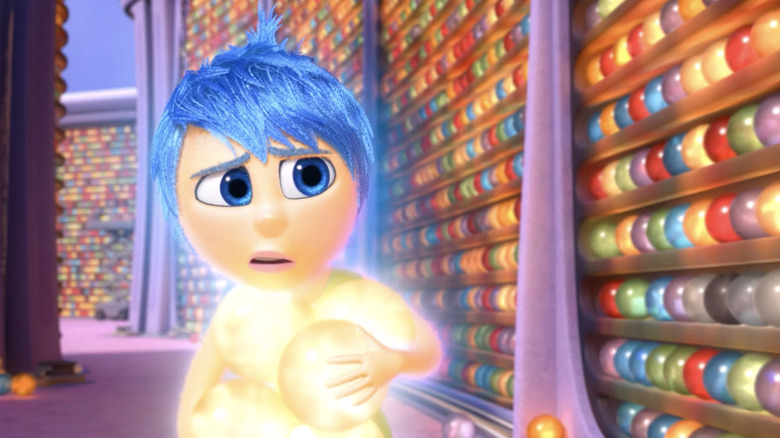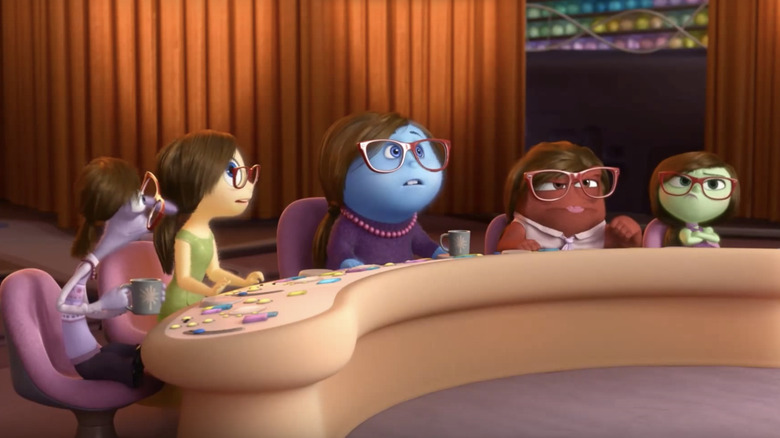Things In Inside Out You Only Notice As An Adult
Inside Out, a classic Pixar offering, is a brilliant and poignant film that both kids and adults love. Released in 2015, it tells the story of a young girl named Riley who has to adjust to her new life after she and her parents move from Minnesota to San Francisco. She struggles with depression in her new city, and has to navigate through a world that can often be intimidating and even scary.
But that's only half of the story of Inside Out. Arguably, the real stars of the film are five of Riley's emotions: Joy, Sadness, Anger, Fear, and Disgust. These feelings are all personified as unique and affable characters who are responsible for maintaining Riley's emotional life.
Like many Pixar films, Inside Out has some masterful subtleties thanks to its slick writing and sense of humor. Here are just a few of the things you only notice in Inside Out as an adult.
Inside Out shows that the Bay Area struggle is real
In the beginning of Inside Out, Riley and her family move from Minnesota, where they had a big house with a yard and access to a lake, to the San Francisco Bay Area — one of the most expensive places to live in the country. There, they have a small house and no big yard or a lake around the corner.
The movie does a good job showing all viewers, young and old, how traumatic moving to a new city can be for a young kid. But as an adult, it's clear that the move shifts the entire family dynamic. Living in an expensive city often means you have to work harder for less. Riley's father is more absent, and when he is around, he's on his phone with his "new venture." Adults familiar with the region collectively groan about that one.
Other nuanced Bay Area-specific observations include Riley's parents' struggle with the new compost/recycle bins, reflecting the environmentally conscious spirit of the region. And, yes, broccoli on pizza is not at all shocking there, either, as folks in the Bay Area are among the most health-conscious in the country. Finally, the classroom is visibly racially diverse, which is an accurate portrayal of the region's demographics.
Why does Inside Out's Riley walk to school on her own?
Any kid who's had to go to a new school can empathize with Riley's struggle, as changing schools can be a very stressful event for kids. It's no surprise that Riley is nervous about her prospects in Inside Out.
When the day finally arrives for Riley to face her fears and go to school, her parents offer to walk with her, but she declines. She's clearly not thrilled at the idea of being seen with her parents by her new classmates, which Disgust makes clear.
But how would she know the area well enough to get there? Has she ever even been in the building? And why would her parents trust her walking on her own at that age, especially in a city as big as San Francisco? They're definitely not in rural Minnesota anymore, so why are they just throwing her to the wolves?
There are Pixar shout-outs in Inside Out
One thing Pixar is really good at is placing Easter eggs in their films, and the animated film Inside Out is no exception. The movie has a bunch of shout-outs to Pixar projects like Monsters Inc. and For The Birds, as well as other movies that are a bit too slick for most kids to notice.
For example, if you're fast enough, you can see images from the opening montage of Up in some of the memory orbs. Remember Ratatouille? The dead mouse in Riley's new home (and subsequent dream sequence) looks a lot like Remy. Did you notice Andy's globe from Toy Story in the classroom? And if you look carefully at the boxes next to the house of cards in Imagination Land, you'll see a nod to Finding Nemo, as one of them has an orange fish and the text "find me" on it.
There are definitely bears in San Francisco, according to Inside Out
Pixar knows that parents will comprise their audience as much as kids, if not more, so every now and then they write in some edgier jokes for adult amusement. While Riley is laying in bed in her new home in Inside Out, after the character has moved to San Francisco with her mom and dad, the lights and sounds of her new neighborhood frighten her. While she pulls the covers up over her face to hide, Fear asks, "What was that? Was it a bear? It's a bear!"
Disgust responds, "There are no bears in San Francisco," which is true — if you're talking about the furry animal who lives in the woods and eats fish. But there are plenty of the other kind of bears, which Anger notices. "I saw a really hairy guy. He looked like a bear," he says. Well played, Pixar.
Inside Out comments on the difference between facts and opinions
Blink and you'll miss it, but there's some incisive commentary that goes down on the train of thought in Disney and Pixar's animated movie Inside Out. Joy, who's caught up in the prospect of finally getting home, accidentally knocks over boxes of both facts and opinions. The boxes fall to the ground, with facts and opinions landing in a mixed-up pile. Joy, who's concerned over the matter, says, "Oh no! These facts and opinions look so similar!" However, Bing Bong calms her down, responding, "Ah, don't worry about it — happens all the time!"
This is an especially poignant observation in the "fake news era" in America, where there are facts and then there are "alternative facts." Even though the film Inside Out was made in 2015, it resonates in a new way with adult viewers years later, as the statement makes a lasting impression.
Riley loses her marbles
One brilliant metaphor in Inside Out is the depiction of memories as marbles — that's a direct nod to the expression, "losing your marbles," which refers to memory loss. The character Joy spends almost the entire time of the movie making sure that she doesn't lose Riley's marbles, fiercely protecting precious core memories.
Additionally, you don't have to be a neurosurgeon to notice that the way long-term memory is set up looks a lot like a brain, with its long, winding corridors and rounded shelves. Most kids aren't likely to pick up on that level of complex anatomical referencing, though.
Inside Out's imaginary friend Bing Bong isn't a random mish mash
Riley's imaginary friend, Bing Bong, initially seems like a random amalgam of different animals, both real and imaginary. But Pixar is never one to do anything without a purpose, so even the strange, pink elephant-hybrid in Inside Out is meaningfully constructed.
Bing Bong mentions that he is part elephant and part dolphin, two creatures that are known for having an incredible capacity for memory. Elephants recognize other elephants they've encountered years or even decades previously, proving that they indeed "never forget." And dolphins have the "longest social memory" amongst non-humans.
So even if Riley forgets Bing Bong forever, chances are he'll never forget about her. We're not crying — you're crying!
Long-term memory can be cruel, as shown by Inside Out
Many of the metaphors in Inside Out are accessible to both adult and kid viewers alike. But some of them only make sense to adults with specific life experiences. For example, everyone laughs when the commercial jingle for TripleDent Gum keeps reprising, often at random and inappropriate times. That shows how annoying yet memorable jingles are.
But anyone who's spent years learning a language or perfecting an instrument feels it right in the jugular when the long-term memory workers delete four years of piano lessons. "Save 'Chopsticks' and 'Heart and Soul,' and get rid of the rest," one of the workers says as they suck away years of work. That's a spot-on depiction of how long-term memory often works, which is a bit depressing.
Different people have different pilots in Inside Out
While all of the emotions take turns piloting Riley's brain in Disney and Pixar's Inside Out, Joy is the default, primary driver. That shows that Riley's main mood is usually happiness, and that emotions like Sadness, Anger, Fear, and Disgust are secondary feelings for her. That's the ideal situation for everyone.
But not everyone has Joy at the center of their console. Most notably, when Riley's parents' emotions are shown, Sadness is piloting Mom's console, and Anger is piloting Dad's console. And, while kids might not pick up on it, that reveals a deeper truth about how — due to a combination of both nature and nurture — each gender expresses their emotions: Men are more prone to expressing their anger than women, and women are more likely to express their sadness than men are. It's subtle, but it's a poignant observation, especially for a children's movie.
